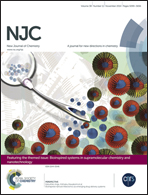Theoretical investigations on one- and two-photon absorptions for a series of covalently functionalized hybrid materials based on graphene†
Abstract
Recently, the covalently linked porphyrin–graphene composite materials with excellent nonlinear optical (NLO) properties and solubility have been experimentally studied, but their two-photon absorption (TPA) properties have not been reported yet. In this work, a series of novel graphene-like molecules and their corresponding hybrids with porphyrin have been designed to study their one-photon absorption (OPA) and TPA properties, as well as the structure–property relationships by employing quantum-chemical calculations. The maximum TPA cross sections (δmax) calculated by the ZINDO method, combined with the FTRNLO-JLU program compiled by our group, are as large as ∼913.0–3904.3 GM. Moreover, both molecular size and porphyrin result in a significant increase of the δmax values. Furthermore, the hybrid molecules possess a higher TPA response resulting from intramolecular charge transfer, compared with their counterparts without a porphyrin. The calculated results support the experimentally observed trends, as well as indicate that the designed compounds with large TPA cross-sections have potential for applications involving optical limiting and two-photon fluorescence microscopy (TPFM). We expect that this study will provide a theoretical perspective for designing novel TPA materials based on graphene for further applications in the future.


 Please wait while we load your content...
Please wait while we load your content...